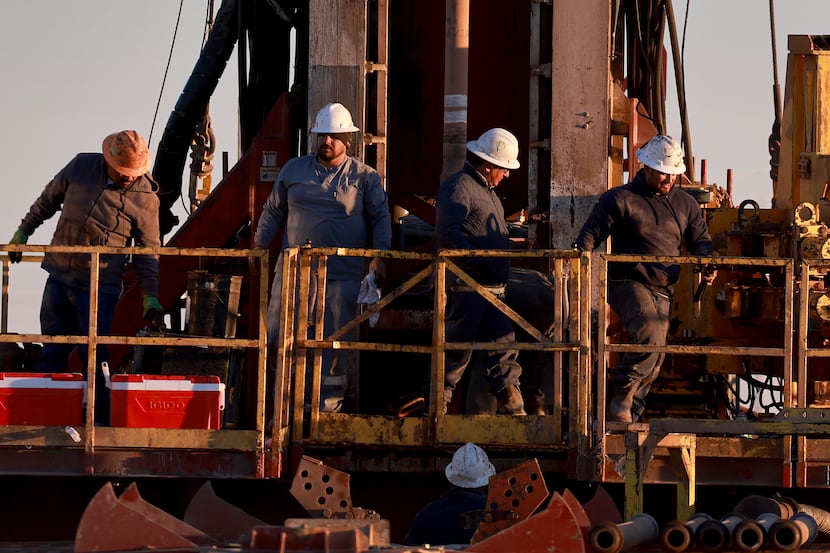What a difference a few years make in the Texas oil patch.
Oil and gas production keeps growing, the sector has been adding jobs at a torrid pace, and most companies have been investing more.
In a December survey by Federal Reserve Bank of Dallas, almost two-thirds of oil and gas executives reported an increase in capital spending compared with a year earlier — and almost two-thirds expect to increase spending in 2023.
“Like it or not, oil and gas is here to stay for a very long time,” an executive from an exploration and production firm told the Dallas Fed. “Our request is simple: Get out of our way and we will deliver cheap energy.”
For the 12 months ending in October, crude oil production rose 7% in the U.S., reaching 12.38 million barrels daily. Texas’ daily production hit almost 5.2 million barrels in October, up 4.6%.
Those volumes are just shy of the record set in late 2019, shortly before the pandemic arrived. But in 2023, U.S. production is projected to edge higher and set a new high, driven by the Permian Basin region in West Texas. The Permian is expected to increase output by 440,000 barrels a day, according to the U.S. Energy Information Administration.
Natural gas withdrawals are at record highs already, led by a 5.1% increase in Texas for the year ended in October.
The energy agency cited the Dallas Fed survey, noting that responses suggested increased activity, especially with most companies planning to boost capital spending this year.
According to the survey, optimism waned in the fourth quarter amid concerns about inflation, supply bottlenecks and availability of capital and labor. The threat of recession may temper some enthusiasm, said Michelle Michot Foss, a fellow in energy, minerals and materials at Rice University’s Baker Institute.
“But the math is just too compelling,” Michot Foss wrote in an email. “The writing is on the wall. Demand is not going away (other than any recession effects).”
Job growth is one proxy of the surging rebound in the Texas oil patch. The number of employees working in oil and gas extraction and support activities rose almost 22%, to nearly 210,000, in the 12 months ended in November. That growth rate was about four times faster than the 5.1% increase in all nonfarm jobs in Texas, according to estimates from the U.S. Bureau of Labor Statistics.
The unemployment rate in Midland, a key center for the Permian, was 2.8% in November, among the lowest in the state. Nationwide, the unemployment rate for workers in the sector that includes oil and gas was just 1.9% in December.
“There’s strong demand, but the employees are no longer there,” said Kunal Patel, senior business economist at the Dallas Fed.
The survey pointed to strong growth in employment, hours and wages in the fourth quarter. But a history of boom-bust cycles, which included deep layoffs in 2009, 2015 and 2020, has made it difficult to recruit and retain.
“It’s just that most people are looking for a career,” Patel said.
How tight is the labor market? “Our company is relying more heavily on rotational employees to service equipment,” said one operator in the Permian.
With local infrastructure stretched to the max, “We are seeing an increase in safety incidents due to poor road conditions and traffic,” the executive said.
The oil and gas industry often complains about government regulation and opposition to fossil fuels. But even if all regulations were removed, activity couldn’t be increased more than 10% because of the worker shortage, an executive said: “Automation cannot drill wells, move rigs and build locations.”
Despite concerns about labor, it is not the primary obstacle to growth. That goes to cost inflation and supply bottlenecks, cited by 32% of exploration and production firms when asked about the biggest drag on boosting output.
Just 8% selected labor as the biggest headwind to increasing production of oil and gas.
“Inflation continues to be a top-of-mind issue in exploration and production,” an executive told the Dallas Fed. “We are girding ourselves for further cost increases in 2023. This is against a backdrop of commodity price uncertainty and fears of demand destruction owing to recession.”
Inflation is a major contributor to this year’s higher capital spending plans, Patel said. Add in the threat of recession and continuing supply problems, and that ramps up the uncertainty, which tempers optimism.
In the survey, roughly half the executives reported an increase in uncertainty from the previous quarter — and from a year earlier.
“They’re not as optimistic as they normally would be,” Patel said. “From a high level, activity continues to grow and they’re going to spend more. But some of that [spending] is going to be eaten up by cost inflation.”
Both natural gas and crude oil prices have been volatile in the past year, in part because of Russia’s invasion of Ukraine and the sanctions that followed. Crude oil sold for about $80 a barrel at the start of 2022, rose to over $120 in early summer and has retreated back into the $70s.
When asked what price they were using for planning their capital spending in 2023, the median response was $75 a barrel, the Dallas Fed said.
Michot Foss of Rice said she was optimistic about the fossil fuel industry attracting more investment, both in the near- and long-term. One reason is there aren’t enough materials to build out energy replacements at scale.
“For all of the pressure to paint the oil and gas businesses as riding off into the sunset,” she said, “the fact of the matter is that replacing these commodities will be exceedingly painful.”

